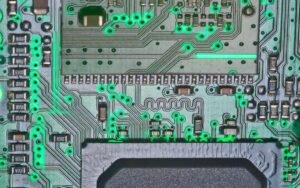Why Buy Air Purifier
An air purifier is a device that helps improve indoor air quality by removing contaminants such as dust, pollen, pet dander, smoke particles, and other pollutants. If you’re considering buying an air purifier for your home or office, it’s important to understand the benefits it can offer.
Key Takeaways:
- Improved indoor air quality
- Reduction in allergens and respiratory irritants
- Enhanced breathing and overall health
- Reduction in odors and unpleasant smells
- Increased comfort and well-being
One of the primary reasons to buy an air purifier is to improve indoor air quality. **Indoor air can sometimes be more polluted** than outdoor air due to various factors such as inadequate ventilation, accumulation of indoor pollutants, and allergens brought in from the outside. Air purifiers can help filter out these contaminants, providing cleaner and healthier air indoors.
Indoor air pollution is a significant concern for individuals suffering from allergies or respiratory conditions. **Air purifiers can be highly effective in reducing allergens** like pollen, dust mites, and pet dander, providing relief from symptoms and improving overall respiratory health.
Moreover, air purifiers can also help remove smoke particles and other irritants from the air, thus promoting **better breathing** and reducing the risk of respiratory problems. By removing these particles, air purifiers can create a safer environment for individuals with asthma or other respiratory conditions.
Types of Air Purifiers:
- High-Efficiency Particulate Air (HEPA) filters
- Activated carbon filters
- Ionizers
- Ultraviolet (UV) germicidal irradiation
When it comes to choosing an air purifier, there are several types available on the market. One popular type is a **HEPA filter**, which stands for High-Efficiency Particulate Air. These filters are designed to capture particles as small as 0.3 microns, efficiently removing allergens, dust, and pet dander from the air.
Another type of air purifier uses **activated carbon filters**, which are effective in removing odors, gases, and volatile organic compounds (VOCs). These filters work by adsorbing the pollutants onto their surface, helping to improve the overall indoor air quality.
| Type of Air Purifier | Advantages | Disadvantages |
|---|---|---|
| HEPA filter | Highly efficient in removing particles and allergens | May not capture odors or chemicals |
| Activated carbon filter | Effective in removing odors, gases, and VOCs | May require frequent replacement |
Ionizers are another type of air purifier that work by releasing negatively charged ions into the air. These ions attach to positively charged particles, causing them to become too heavy to stay airborne and ultimately settling on surfaces. This helps to **reduce the presence of dust and other particles** in the air, making it easier to clean and breathe.
Some air purifiers also incorporate **ultraviolet (UV) germicidal irradiation** as a means to kill bacteria, viruses, and other microorganisms in the air. By using UV light, these purifiers can provide an added layer of protection against harmful pathogens.
Benefits of Using an Air Purifier:
- Reduces exposure to pollutants and respiratory irritants
- Improves sleep quality
- Helps in managing allergies and asthma
- Creates a cleaner and healthier environment
Using an air purifier can have numerous benefits for both your health and overall well-being. **By reducing the amount of pollutants** in the air, air purifiers can help minimize your exposure to respiratory irritants and allergens, resulting in fewer allergy symptoms and improved respiratory health.
Additionally, air purifiers can **improve sleep quality** by creating a cleaner and quieter environment. By removing airborne particles that could potentially disrupt sleep, such as dust and pet dander, air purifiers can contribute to a more restful night’s sleep and better overall sleep quality.
| Time spent indoors on average | Percentage of people suffering from allergies |
|---|---|
| 90% | 30% |
If you or your family members suffer from allergies or asthma, using an air purifier can be particularly beneficial. Air purifiers can **help manage allergies and asthma** by effectively removing allergens and respiratory irritants from the air. This can lead to a reduction in symptoms such as sneezing, coughing, and wheezing, improving the overall quality of life for individuals with these conditions.
To sum up, investing in an air purifier is a wise decision for anyone looking to improve indoor air quality, reduce allergens and respiratory irritants, and create a healthier living environment. With a wide range of options available, finding the right air purifier for your specific needs and preferences is essential in reaping the maximum benefits it can provide.

Common Misconceptions
Misconception 1: Air purifiers are unnecessary
One common misconception about air purifiers is that they are unnecessary and only designed for people with respiratory issues. However, air purifiers are beneficial for everyone, as they help to remove allergens, pollutants, and odors from the air, creating a clean and healthy environment.
- Air purifiers can help reduce the number of airborne bacteria and viruses
- They can mitigate the effects of indoor air pollution, which can be more harmful than outdoor pollution
- Using an air purifier can improve the overall air quality and circulation in your home or office
Misconception 2: Opening windows can provide the same results as an air purifier
Another misconception is that simply opening windows can provide the same results as using an air purifier. While fresh air from outside can be beneficial, it does not necessarily address specific indoor pollutants. Air purifiers are designed to filter out pollutants and allergens, providing a more targeted solution to improving air quality.
- Air purifiers can effectively remove dust, pet dander, and pollen from the air, which may enter through open windows
- They can also filter out pollutants such as smoke, chemicals, and volatile organic compounds (VOCs)
- An air purifier can continuously clean the air indoors, even when windows are closed
Misconception 3: Air purifiers are noisy and expensive to maintain
Many people believe that air purifiers are noisy and require expensive maintenance. While some cheaper models may generate noise, there are various types of air purifiers available with different noise levels. Additionally, maintenance costs can vary depending on the brand and model of the purifier.
- Modern air purifiers are designed to operate quietly, and some even have a sleep mode for silent operation at night
- Filter replacements can be affordable, and some purifiers have washable or reusable filters that reduce maintenance costs
- Consider long-term benefits and potential savings on medical bills from improved indoor air quality when evaluating the cost of an air purifier
Misconception 4: Air purifiers can eliminate all indoor pollutants
It is important to note that while air purifiers are effective at removing many indoor pollutants, they cannot eliminate them all. Some larger particles or gases may not be effectively captured by certain air purifiers. It is essential to choose the right type of purifier for your specific needs.
- HEPA filters (High-Efficiency Particulate Air) are highly effective at capturing particles as small as 0.3 microns
- Activated carbon filters can help absorb and neutralize odors and certain chemicals
- Consider specialized air purifiers, such as smoke purifiers or those designed for pet owners, to address specific pollutants
Misconception 5: Air purifiers are a hassle to use and require constant monitoring
Lastly, people often assume that air purifiers are difficult to use and require constant monitoring. However, many air purifiers are designed to be user-friendly and can operate automatically once properly set up.
- Some air purifiers have built-in sensors that detect air quality and adjust the settings accordingly
- Set timers or use programmable features to control operation schedules, reducing the need for constant monitoring
- Regularly clean or replace air filters as directed, but they generally do not require constant attention

Table: Benefits of Air Purifiers
Air purifiers are becoming increasingly popular as people prioritize their health and well-being. This table highlights some of the key benefits of investing in an air purifier.
| Benefit | Description |
|---|---|
| Removes allergens | Filters out dust, pollen, pet dander, and other allergens, reducing allergy symptoms. |
| Eliminates odors | Effectively removes unpleasant smells from cooking, pets, smoke, and other sources. |
| Captures airborne bacteria | Traps and prevents the growth of harmful bacteria, promoting a healthier living environment. |
| Reduces asthma triggers | Minimizes common asthma triggers, such as dust mites, mold spores, and air pollutants. |
| Improves sleep quality | Cleaner air enhances sleep by removing irritants and providing a more comfortable environment. |
| Enhances lung health | Helps individuals with respiratory issues breathe easier and improves overall lung function. |
| Reduces pet-related issues | Addresses pet-related allergies and keeps pet hair and dander from circulating in the air. |
| Filters out toxins | Removes harmful toxins released from cleaning products, furniture, and everyday pollutants. |
| Decreases indoor pollutants | Filters out various indoor pollutants, such as VOCs, formaldehyde, and tobacco smoke. |
| Prevents illness | Reduces the risk of respiratory illnesses caused by airborne viruses and bacteria. |
Table: Air Purifier Technologies
The effectiveness of air purifiers lies in the technology they employ. This table lists different air purifier technologies and their respective advantages.
| Technology | Advantages |
|---|---|
| HEPA Filtration | Highly efficient at capturing airborne particles as small as 0.3 microns, including allergens and dust. |
| Activated Carbon | Effectively absorbs odors, smoke, and harmful chemicals, improving overall air quality. |
| UV-C Light | Destroys viruses, bacteria, and mold spores by altering their DNA, preventing them from reproducing. |
| Ionization | Produces negative ions that attach to airborne particles, causing them to be attracted to surfaces and removed from the air. |
| Ozone Generators | Generates ozone to neutralize odors and kill bacteria, but should be used with caution and in limited quantities. |
Table: Air Quality Index (AQI) Levels
Understanding the Air Quality Index (AQI) levels helps gauge the air pollution levels and take necessary precautions. This table categorizes AQI levels and their corresponding impact.
| AQI Level | Impact |
|---|---|
| 0-50 | Good – Air quality is satisfactory, and air pollution poses little to no risk. |
| 51-100 | Moderate – Air quality is acceptable, but individuals with respiratory issues may experience slight discomfort. |
| 101-150 | Unhealthy for Sensitive Groups – People with respiratory or heart conditions may experience mild adverse effects. |
| 151-200 | Unhealthy – General population may experience adverse effects, and sensitive individuals can face more significant health risks. |
| 201-300 | Very Unhealthy – Health warnings of emergency conditions, as everyone is likely to be affected. |
| 301+ | Hazardous – Health emergencies, with the entire population being at risk and immediate action needed to protect oneself. |
Table: Cost Comparison of Air Purifiers
When considering purchasing an air purifier, comparing costs can help make an informed decision. This table presents a cost comparison of various air purifier models.
| Air Purifier Model | Price Range | Key Features |
|---|---|---|
| Model A | $100-$150 | HEPA filter, three-speed settings, suitable for small to medium rooms. |
| Model B | $200-$250 | HEPA and activated carbon filters, remote control, air quality sensor, ideal for larger rooms. |
| Model C | $300-$350 | HEPA, activated carbon, and UV-C light technologies, Wi-Fi-enabled, smartphone app control. |
| Model D | $400-$450 | Multiple filters including HEPA, activated carbon, and ionization, customizable settings, energy-efficient. |
Table: Indoor Air Pollutants
Identifying common indoor air pollutants can help understand the need for air purifiers. This table highlights some prevalent indoor pollutants and their sources.
| Pollutant | Source |
|---|---|
| Dust | Dead skin cells, textiles, furniture, and outdoor pollutants entering through windows and ventilation. |
| Volatile Organic Compounds (VOCs) | Cleaning products, paints, varnishes, solvents, adhesives, and certain household items. |
| Pollen | Plants, trees, grasses, and weeds releasing pollen into the air, especially during pollen seasons. |
| Mold Spores | Damp areas, such as bathrooms, basements, and areas affected by water damage or high humidity. |
| Tobacco Smoke | Secondhand smoke, smoking indoors, and smoke particles clinging to clothing and furniture. |
| Pet Dander | Shed skin cells, fur, or feathers from pets, including cats, dogs, birds, and other animals. |
Table: Noise Levels of Air Purifiers
Considering noise levels can be essential for maintaining overall comfort. This table provides noise level comparisons of different air purifier models.
| Air Purifier Model | Noise Level (Decibels) |
|---|---|
| Model X | 25 dB |
| Model Y | 40 dB |
| Model Z | 55 dB |
| Model P | 62 dB |
Table: Air Purifier Brands and Ratings
Considering reputable brands with excellent ratings can ensure high-quality air purification. This table showcases some popular air purifier brands and their ratings.
| Brand | Rating (out of 5) |
|---|---|
| Brand A | 4.6 |
| Brand B | 4.8 |
| Brand C | 4.4 |
| Brand D | 4.9 |
Table: Air Purifier Coverage Area
The coverage area of an air purifier determines its ability to efficiently clean the air in a given space. This table showcases different air purifier models and their respective coverage areas.
| Air Purifier Model | Coverage Area |
|---|---|
| Model M | 250 sq. ft. |
| Model N | 500 sq. ft. |
| Model O | 750 sq. ft. |
| Model Q | 1,000 sq. ft. |
Table: Energy Consumption Comparison
Energy consumption is an important factor in selecting an air purifier. This table compares the wattage and energy consumption of different air purifier models.
| Air Purifier Model | Wattage | Energy Consumption (per hour) |
|---|---|---|
| Model R | 50 W | 0.05 kWh |
| Model S | 70 W | 0.07 kWh |
| Model T | 90 W | 0.09 kWh |
| Model U | 110 W | 0.11 kWh |
Air purifiers have become an indispensable appliance for many households, offering numerous health benefits and ensuring cleaner indoor air quality. The tables displayed above provide invaluable insights into the different aspects of air purifiers, ranging from their benefits and technologies to cost comparisons, noise levels, and energy consumption. By understanding the impact of air pollutants, the importance of the Air Quality Index, and the diverse array of air purifier models available, individuals can make well-informed decisions when considering the purchase of an air purifier. Investing in an air purifier not only improves overall health and well-being but also creates a more comfortable living environment for everyone present.
Frequently Asked Questions
What are the benefits of buying an air purifier?
An air purifier can help to improve the indoor air quality by removing dust, pollen, pet dander, and other pollutants. It can also reduce allergy and asthma symptoms, eliminate odors, and promote better respiratory health.
How does an air purifier work?
An air purifier typically uses a combination of filters, such as HEPA filters, activated carbon filters, and pre-filters, to capture and remove airborne particles and pollutants. The air is drawn into the purifier, passes through the filters, and then clean air is released back into the room.
What types of pollutants can an air purifier remove?
An air purifier can remove various pollutants, including dust, pollen, pet dander, mold spores, smoke particles, volatile organic compounds (VOCs), and odors.
What size air purifier do I need?
The size of the air purifier you need depends on the square footage of the room or area you want to purify. Most air purifiers have a recommended coverage area specified by the manufacturer, so you can choose one that suits your needs.
Are there any ongoing costs associated with using an air purifier?
Yes, there may be ongoing costs involved with operating an air purifier. These costs can include replacing filters, which usually need to be replaced every few months or annually, and electricity usage.
Can an air purifier help with allergies?
Yes, an air purifier can help reduce allergens in the air, such as pollen, dust mites, and pet dander, which can trigger allergy symptoms. HEPA filters are especially effective at capturing these allergens.
Can an air purifier remove viruses and bacteria?
Some air purifiers with advanced filtration systems, such as those with UV-C light technology or electrostatic precipitators, can help in reducing certain viruses and bacteria. However, it is important to note that an air purifier should not be solely relied upon for complete elimination of these microorganisms.
Are there any noise considerations when using an air purifier?
Most air purifiers produce some level of noise while operating. The noise level can vary depending on the model and fan speed settings. It is recommended to check the product specifications or reviews to determine the noise level of a particular air purifier.
How do I maintain and clean an air purifier?
Regular maintenance of an air purifier is essential for optimal performance. This typically involves cleaning or replacing the filters, cleaning the exterior surfaces of the purifier, and inspecting for any mechanical issues. The specific maintenance instructions can be found in the user manual provided by the manufacturer.
Can an air purifier help with cooking odors or cigarette smoke?
Yes, an air purifier with activated carbon filters can effectively reduce cooking odors and cigarette smoke by adsorbing the odor-causing molecules. It is important to choose an air purifier with appropriate activated carbon filter capabilities for these specific concerns.




